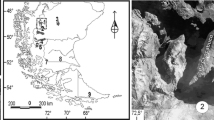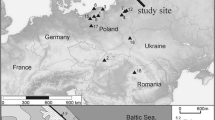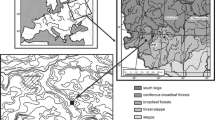Abstract
Actual ecological research postulates for alder carrs a cyclic alternation of Alnus tree vegetation with open fen or Salix dominated vegetation. Such cycles are also indicated in palaeo-ecological studies, but normally the temporal resolution of these studies is insufficient to resolve the duration of short-term cycles in vegetation development. This paper presents a high resolution palaeoecological study (including pollen, macrofossils and non-pollen palynomorphs) of a Late Holocene wood peat section from the small, long-term Alnus dominated peatland ‘Heger Soll’ in the ‘Rodder Forst’ in Western Pomerania (NE Germany) to reconstruct short-term vegetation changes. During a time-span of ca. 800 years, sedge-dominated fen vegetation types alternated with two phases of Alnus carr and one phase of Salix shrubland. The alder carr decline coincided with the beginning of intensified human activity in the surroundings of the mire and was probably connected to increased water discharge resulting from large-scale deforestation, after which willow scrub and sedge fen became established. Growth of Alnus trees was associated with prolonged phases of reduced human impact and probably less water supply. This study shows that human impact on the uplands surrounding the mire and on the alder carr itself may explain the observed “cyclic” vegetation development of alder carrs, willow scrubs and sedge fens in Central Europe.









Similar content being viewed by others
References
Aas G (2003) Die Schwarzerle, Alnus glutinosa – dendrologische Anmerkungen. In Hamberger J (ed) Beiträge zur Schwarzerle. Bayerische Landesanstalt für Wald und Forstwirtschaft, Freising, pp 7–10
Andersen ST (1979) Identification of wild grass and cereal pollen. Danmarks Geol Undersøg Årbog 1978:69–92
Bakker M, Van Smeerdijk DG (1982) A palaeoecological study of a Late Holocene section from ‘Het Ilperveld’, Western Netherlands. Rev Palaeobot Palynol 36:95–163
Barthelmes A (2000) Paläoökologische Untersuchungen zur Entstehung von Erlen-Bruchwaldtorfen. MSc Thesis, University of Greifswald, Greifswald
Barthelmes A (2002) Vom Kesselmoor zum Quellmoor – ungewöhnliche Moorbildungssequenzen im Rodder Forst (Mecklenburg-Vorpommern). Greifswalder Geogr Arbeiten 26:131–134
Barthelmes A. (2009) Vegetation dynamics and carbon sequestration of Holocene alder (Alnus glutinosa) carrs in NE Germany. PhD Thesis, Greifswald University, Greifswald
Barthelmes A, Prager A, Joosten H (2006) Palaeoecological analysis of Alnus wood peats with special attention to non-pollen palynomorphs. Rev Palaeobot Palynol 141:33–51
Bäßler M, Jäger EJ, Werner K (eds) (1996) Rothmaler – Exkursionsflora von Deutschland 2. Gustav Fischer, Jena, Stuttgart
Benkert D, Fukarek F, Korsch H (eds) (1996) Verbreitungsatlas der Farn- und Blütenpflanzen Ost-deutschlands. Gustav Fischer, Jena, Stuttgart, Lübeck, Ulm
Berggren G (1969) Atlas of seeds and small fruits of Northwest-European plant species with morphological descriptions, 2 – Cyperaceae. Swedish National Science Research Council, Stockholm
Berglund BE, Birks HJB, Ralska-Jasiewiczowa M, Wright HE (eds) (1996) Palaeoecological events during the last 15 000 years. J. Wiley, Chichester
Białobrzeska M, Truchanowiczówna J (1960) The variability of shape of fruits and scales of the European birches (Betula L.) and their determination in fossil material. Monogr Bot 9:87–92
Brown AG (1988) The palaeoecology of Alnus (alder) and the postglacial history of floodplain vegetation. Pollen percentage and influx data from the West Middlands, United Kingdom. New Phytol 110:425–436
Clausnitzer U, Succow M (2001) Vegetationsformen der Gebüsche und Wälder. In Succow, M, Joosten H (eds) Landschaftsökologische Moorkunde. E. Schweizerbart’sche Verlagsbuchhandlung (Nägele u. Obermiller), Stuttgart, pp 161–170
De Klerk P (2002) Changing vegetation patterns in the Endinger Bruch area (Vorpommern, NE Germany) during the Weichselian Lateglacial and Early Holocene. Rev Palaeobot Palynol 119:275–309
De Klerk P (2004) Confusing concepts in Lateglacial stratigraphy and geochronology: origin, consequences, conclusions (with special emphasis on the type locality Bøllingsø). Rev Palaeobot Palynol 129:265–298
De Klerk P, Joosten H (2007) The difference between pollen types and plant taxa: a plea for clarity and scientific freedom. Eiszeitalter und Gegenwart/Quatern Sci J 56:162–171
Dinter W, Bohn U (1998) Zur Soziologie und Ökologie von Alnus glutinosa in Mitteleuropa. Jahrb Ges Ingenieurbiol e.V. 7:65–80
Döring U (1987) Zur Feinstruktur amphibischer Erlenbruchwälder. Kleinstandortlicher Differenzierungen in der Bodenvegetation des Carici elongatae-Alnetum im Hannoverschen Wendland. Tuexenia 7:347–366
Döring-Mederake U (1990) Alnion forests in Lower Saxony (FRG), their ecological requirements, classification and position within Carici elongatae-Alnetum of Northern Central Europe. Pl Ecol 89:107–119
Ellenberg H (1986) Vegetation Mitteleuropas mit den Alpen in ökologischer Sicht. Ed. 4. Eugen Ulmer, Stuttgart
Ellenberg H, Weber HE, Düll R, Wirth V, Werner W, Paulißen D (1992) Zeigerwerte der Gefäßpflanzen Mitteleuropas. Ed. 2. Scripta Geobotanica 18, Goltze KG, Göttingen
Eschenbach C (1995) Zur Physiologie und Ökologie der Schwarzerle (Alnus glutinosa). PhD Thesis, University of Kiel, Kiel
Fægri K, Iversen J (1989) Textbook of pollen analysis, 4th edition (revised by Fægri K, Kaland PE, Krzywinski K). John Wiley and Sons, Chichester
Frahm JP, Frey W (1992) Moosflora. Eugen Ulmer, Stuttgart
Fott B (1959) Algenkunde. Gustav Fischer, Jena
Gill CJ (1970) The flooding tolerance of woody species – a review. Forest Abstr 31:671–688
Grimm EC (1992) TILIA 1.12 and TILIAGRAPH 1.18 (software). Illinois State Museum, Springfield, Illinois
Grimm EC (2004) TGView 1.6.2 (software). Illinois State Museum, Springfield, Illinois
Grosse-Brauckmann G, Streitz B (1992) Pflanzliche Makrofossilien mitteleuropäischer Torfe. III. Früchte, Samen und einige Gewebe (Fotos von fossilen Pflanzenresten). Telma 22:53–102
Haeupler H, Schönfelder P (eds) (1989) Atlas der Farn- und Blütenpflanzen der Bundesrepublik Deutschland. Ed 2. Eugen Ulmer, Stuttgart
Hofmann G (2003) Die Schwarz-Erle (Alnus glutinosa (L.) Gaertn.) in der Waldvegetation des ostdeutschen Tieflandes. Eberswalder Forstl Schriftenreihe 17:19–38
Jäger EJ, Werner K (2005) Rothmaler – Exkursionsflora von Deutschland, Kritischer Band 4. Ed. 10, Spektrum, München
Janke V, Janke W (1970) Zur Entstehung und Verbreitung der Kleingewässer im nordostmecklenburgischen Grundmoränenbereich. Arch Naturschutz Landschaftsforsch 10:3–18
Janssen CR (1959) Alnus as a disturbing factor in pollen diagrams. Acta Bot Neerl 8:55–58
Janssen CR (1966) Recent pollen spectra from the deciduous and coniferous-deciduous forest of Northeastern Minnesota: a study in pollen dispersal. Ecology 47:804–825
Janssen CR (1973) Local and regional pollen deposition. In Birks HJB, West RG (eds) Quaternary plant ecology. 14th Symposium of the British Ecological Society, Blackwell Scientific Publications, Oxford, pp 31–42
Janssen CR, IJzermans-Lutgerhorst W (1973) A ‘local’ Late-Glacial pollen diagram from Limburg, The Netherlands. Acta Bot Neerl 22:213–220
Jeník J, Končalová MN, Jičínská D, Přibil S (2002) Willow carr: dominants and life strategies. In Květ J, Jeník J, Soukupová L (eds) Freshwater wetlands and their sustainable future – a case study of the Třeboň Basin Biosphere Reserve, Czech Republik. Man and Biosphere Series 28:269–282
Joosten H, De Klerk P (2002) What’s in a name? Some thoughts on pollen classification, identification, and nomenclature in Quaternary palynology. Rev Palaeobot Palynol 122:29–45
Joosten H, De Klerk P (2007) DAMOCLES: a DAshing MOnolith Cutter for fine sectioning of peats and sediments into LargeE Slices. Boreas 36:76–81
Kac NJ, Kac SW (1933) Atlas rastitel’nykh ostatkov v torfe (Atlas of plant remnants in peat). Gosudarstvennoe izdatel’stvo kolkhoznoi i sovkhoznoi literatury, Moscow
Kac NJ, Kac SV, Kipiani MG (1965) Atlas i opredelitel’ plodov i semyan vstrechayushchikhsya v chetvertichnykh otlozheniyakh SSSR. (Atlas and keys of fruits and seeds occurring in the Quaternary deposits of USSR). Nauka, Moscow
Kalis AJ, Van der Knaap WO, Schweizer A, Urz R (2006) A three thousand year succession of plant communities on a valley bottom in the Vosges Mountains, NE France, reconstructed from fossil pollen, plant macrofossils and modern phytosociological communities. Veg Hist Archaeobot 15:377–390
Kangas CK (1990) Long-term development of forested wetlands. In Lugo AE, Brinson M, Brown S (eds) Forested wetlands. Ecosystems of the World 15. Elsevier, Amsterdam, pp 25–51
Kätzel R (2003) Zum physiologischen Anpassungspotential der Schwarz-Erle. In Die Schwarz-Erle (Alnus glutinosa (L.) Gaertn.) im nordostdeutschen Tiefland. Eberswalder Forstl Schriftenreihe 17:39–45
Klafs G, Jeschke L, Schmidt H (1973) Genese und Systematik wasserführender Ackerhohlformen in den Nordbezirken der DDR. Arch Naturschutz Landschaftsforsch 13:287–307
Komárek J, Jankovská V (2001) Review of the green algal genus Pediastrum; implication for pollenanalytical research. Biblioth Phycol 108:1–127
Körber-Grohne U (1964) Bestimmungsschlüssel für subfossile Juncus-Samen und Gramineen-Früchte. Probleme der Küstenforschung im südlichen Nordseegebiet 7:1–47
Korpel’ Š (1995) Die Urwälder der Westkarpaten. Gustav Fischer, Stuttgart
Koska I (2004) 13 Klasse: Phragmito-Magno-Caricetea Klinka in Klinka & V. Novák 1941 – Röhrichte, Großseggenriede und Feuchtstaudenfluren nährstoffreicher Standorte. In Berg C, Dengler J, Abdank A, Isermann M (eds) Die Pflanzengesellschaften Mecklenburg-Vorpommerns und ihre Gefährdung (Textband und Tabellenband). Weißdorn-Verlag, Jena, pp 196–224
Krause W (1997) Charales (Charophycea). In Ettl H, Gärtner G, Heynig H, Mollenhauer D (eds) Süßwasser- flora von Mitteleuropa 18. Gustav Fischer, Jena
Landwehr J (1966) Atlas van de Nederlandse Bladmoosen. Erla, Amsterdam
Lang G (1994) Quartäre Vegetationsgeschichte Europas. Gustav Fischer, Jena
Lugo AE, Brison M, Brown S (eds) (1990) Forested wetlands. Ecosystems of the world 15. Elsevier, Amsterdam
Marek S (1965) Biologia i stratygrafia torfowisk olszynowych w Polsce (Biology and stratigraphy of alder bogs in Poland). Zeszymy Problemove Postepów Nauk Rolziczych 57:5–158
McVean DN (1955) Ecology of Alnus glutinosa (L.) Gaertn. II. Seed distribution and germination. J Ecol 43:61–71
McVean DN (1956) Ecology of Alnus glutinosa (L.) Gaertn. III. Seedling establishment. J Ecol 44:195–218
Michaelis D (2001) Schlüssel zur Bestimmung von Braunmoosen aus Torfen anhand einzelner Blättchen. Telma 31:79–104
Middeldorp AA (1982) Pollen concentration as a basis for indirect dating and quantifying net organic and fungal production in a peat bog system. Rev Palaeobot Palynol 37:225–282
Middeldorp AA (1986) Functional palaeoecology of the Hahnenmoor raised bog ecosystem – a study of vegetation history, production and decomposition by means of pollen density dating. Rev Palaeobot Palynol 49:1–73
Moore PD, Webb JA, Collinson ME (1991) Pollen analysis. Blackwell, Oxford
Müller J, Rosenthal G (1998) Brachesukzessionen – Prozesse und Mechanismen. Ber Inst Landschafts- und Pflanzenökol Univ Hohenheim, Beih 5:103–132
Newman C, O’Connell M, Dillon M, Molloy K (2007) Interpretation of charcoal and pollen data relating to a late Iron Age ritual site in eastern Ireland: a holistic approach. Veg Hist Archeobot 16:349–365
Nilson Ö, Helmqvist H (1967) Studies on the nutlet structure of South Scandinavian species of Carex. Bot Not 120:460–485
Ohmann LF, Knighton MD, McRoberts R (1990) Influence of flooding duration on the biomass growth of alder and willow. Res Pap NC-292, US Department for Agriculture, Forest Service, North Central Forest Experiment Station, St. Paul, MN
Pals JP, Van Geel B, Delfos A (1980) Palaeoecological studies in the Klokkeweel bog near Hoogkarspel (Noord Holland). Rev Palaeobot Palynol 30:371–418
Pickett STA (1989) Space-for-time substitution as an alternative to long-term studies. In Likens GE (ed) Long-term studies in ecology. Approaches and alternatives. Springer, New York, pp 110–135
Pokorný P, Klimešová J, Klimeš L (2000) Late Holocene history and vegetation dynamics of a floodplain alder carr: a case study from eastern Bohemia, Czech Republic. Folia Geobot 35:43–58
Prager A, Barthelmes A, Theuerkauf M, Joosten H (2006) Non-pollen palynomorphs from modern Alder carrs and their potential for interpreting microfossil data from peat. Rev Palaeobot Palynol 141:7–31
Punt W (ed) (1976) The northwest European pollen flora I. Elsevier, Amsterdam
Punt W, Clarke GCS (eds) (1980) The northwest European pollen flora II. Elsevier, Amsterdam
Punt W, Clarke GCS (eds) (1981) The northwest European pollen flora III. Elsevier, Amsterdam
Punt W, Clarke GCS (eds) (1984) The northwest European pollen flora IV. Elsevier, Amsterdam
Punt W, Blackmore S (eds) (1991) The northwest European pollen flora VI. Elsevier, Amsterdam
Punt W, Blackmore S, Clarke GCS (eds) (1988) The northwest European pollen flora V. Elsevier, Amsterdam
Punt W, Hoen PP, Blackmore S (eds) (1995) The northwest European pollen flora VII. Elsevier, Amsterdam
Punt W, Blackmore S, Hoen PP, Stafford PJ (eds) (2003) The northwest European pollen flora VIII. Elsevier, Amsterdam
Reimer PJ, Baillie MGL, Bard E, Bayliss A, Beck JW, Bertrand CJH, Blackwell PG, Buck CE, Burr GS, Cutler KB, Damon PE, Edwards RL, Fairbanks RG, Friedrich M, Guilderson TP, Hogg AG, Hugher KA, Kromer B, McCormac G, Manning S, Ramsey CB, Reimer RW, Remmele S, Southon JR, Stuiver M, Talamo S, Taylor FW, Van der Plicht J, Weyhenmeyer CE (2004) Intcal04 terrestrial radiocarbon age calibration, 0–26 cal Kyr BP. Radiocarbon 46:1029–1058
Saarse L, Niinemets E, Poska A, Veski S (2010) Is there a relationship between crop farming and the Alnus decline in the eastern Baltic region? Veg Hist Archaeobot 19:17–28
Sarmaja-Korjonen K (2003) Contemporaneous Alnus decline and the beginning of Iron Age cultivation in pollen stratigraphies from southern Finland. Veg Hist Archaeobot 12:49–59
Schäfer A, Joosten H (2005) Erlenaufforstung auf wiedervernässten Niedermooren. Institut für dauerhaft umwelt-gerechte Entwicklung von Naturräumen der Erde, Greifswald
Smit R, Olff H (1998) Woody species colonisation in relation to habitat productivity. Pl Ecol 139:203–209
Spangenberg A (2008) 2000 Jahre Waldentwicklung auf nährstoff- und basenreichen Standorten in mitteleuropäischen Jungpleistozän – Fallstudie Naturschutzgebiet Eldena (Vorpommern, Deutschland). PhD Thesis, University of Greifswald, Greifswald
Stegner J (2000) Erlenbruchwälder – Dynamik in Raum und Zeit. Konsequenzen für den Prozesschutz in einer Waldgesellschaft. Naturschutz Landschaftsplan 32:262–270
Stockmarr J (1971) Tablets with spores used in absolute pollen analysis. Pollen & Spores 13:615–621
Stuiver M, Reimer PJ (1993) Extended 14C data base and revised Calib 3.0 14C age calibration program. Radiocarbon 35:215–230
Succow M, Joosten H (eds) (2001) Landschaftsökologische Moorkunde. E. Schweizerbart’sche Verlagsbuchhandlung, Stuttgart
Succow M, Stegmann H (2001) Torfarten. In Succow M, Joosten H (eds) Landschaftsökologische Moorkunde. E. Schweizerbart’sche Verlagsbuchhandlung, Stuttgart, pp 58–62
Svobodová H (1997) Die Entwicklung der Vegetation in Südmähren (Tschechien) während des Spätglazials und Holozäns – eine palynologische Studie. Verh Zool-Bot Ges Österreichs 134:317–356
Telford RJ, Heegaard E, Birks HJB (2004) The intercept is a poor estimate of a calibrated radiocarbon age. The Holocene 14:296–298
Tomlinson P (1985) An aid to the identification of fossil buds, bud-scales and catkin-bracts of British trees and shrubs. Circaea 3:45–130
Tucker JJ, Fitter AH (1981) Ecological studies at Askham Bog Nature Reserve. – 2. The population of Far Wood. Naturalist 106:3–14
Van Geel B (1978) A palaeoecological study of Holocene peat bog sections in Germany and The Netherlands, based on analysis of pollen, spores and macro- and microscopic remains of fungi, algae, cormophytes and animals. Rev Palaeobot Palynol 25:1–120
Van Geel B, Hallewas DP, Pals JP (1983) A late Holocene deposit under the Westfriese Zeedijk near Enkhuizen (Prov. of Noord-Holland, The Netherlands): palaeoecological and archaeological aspects. Rev Palaeobot Palynol 38:269–335
Van Geel B, Klink AG, Pals JP, Wiegers J (1986) An upper Eemian lake deposit from Twente, eastern Netherlands. Rev Palaeobot Palynol 47:31–61
Van Geel B, Coope GR, Van der Hammen T (1989) Palaeoecology and stratigraphy of the Lateglacial type section at Usselo (The Netherlands). Rev Palaeobot Palynol 60:25–129
Walentowski H, Ewald J (2003) Die Rolle der Schwarzerle in den Pflanzengesellschaften Mitteleuropas. In Hamberger J (ed) Beiträge zur Schwarzerle. Bayerische Landesanstalt für Wald und Forstwirtschaft, Freising, pp 11–19
Waller MP (1994) Flandrian vegetational history of South–Eastern England. Stratigraphy of the Brede valley and pollen data from the Brede Brigde. New Phytol 126:369–392
Weiße R (1987) Die glaziale Entstehung von Kleinsenken. Petermanns Geogr Mitt 131:103–111
Wheeler BD (1980) Plant communities of rich fen systems in England and Wales. III. Fen meadow, fen grassland and fen woodland communities and contact communities. J Ecol 68:761–788
Wiebe C (1998) Ökologische Charakterisierung von Erlenbruchwälder und ihren Entwässerungsstadien: Vegetation und Standortverhältnisse. Mitt Arbeitsgem Geobot Schleswig-Holstein & Hamburg 56:1–164
Wiegers J (1985) Succession in fen woodland ecosystems in the Dutch haf district. With special reference to Betula pubescens Ehrh. Diss Bot 86:1–152
Wiethold J (1998) Studien zur jüngeren postglazialen Vegetations- und Siedlungsgeschichte im östlichen Schleswig-Holtstein. Universitätsforschungen zur prähistorischen Archäologie 45, Dr. Rudolf Habelt GmbH, Bonn
Young R, Walanus A, Goslar T, van Geel B, Ralska-Jasiewiczowa M, Wijmstra TA (1999) Test of an equal taxon-weighted modification of Middeldorp’s pollen density dating on data from varved sediments of Lake Gościaź. Rev Palaeobot Palynol 104:213–237
Acknowledgements
This research was carried out as a MSc-study of D.G. at Greifswald University in connection to the “ALNUS”-project funded by the Deutsche Bundesstiftung Umwelt. The 14C-dates were provided by the Poznań Radiocarbon Laboratory (headed by Tomasz Goslar) and the Leibniz-Laboratory for Radiometric Dating and Stable Isotope Research in Kiel (headed by Pieter Grootes). We thank John Couwenberg for his help in sampling core ROF and for calculating the ages of zone boundaries (pollen density dating), Erika Retzlaff for preparing the pollen samples, Almut Spangenberg for assistance in identifying microfossils, and Dierk Michaelis for help with the identification of macrofossils.
Author information
Authors and Affiliations
Corresponding author
Electronic supplementary material
Below is the link to the electronic supplementary material.
Electronic Supplementary Material 1
ROD upland pollen diagram (Alnus excluded from pollen sum). Relative frequencies are presented as actual values (closed curves) and with a 5-times exaggeration. The “pollen sum” numbers present the number of grains included in the upland pollen sum. For type nomenclature, see text. (DOC 1330 kb)
Electronic Supplementary Material 2
Pollen concentration diagram ROF—selected types (grey curves—types excluded from pollen sum). Letters (m, g) and asterisks in brackets indicate the literature sources used for identification (see the text for details) (DOC 1395 kb)
Electronic Supplementary Material 3
ROD macrofossil diagram (selected curves only). The histogram presents real values (in volume % or number N per 25 cm³, closed bars) and a 5-times exaggeration (open bars). For further information, see Barthelmes (2009). (DOC 803 kb)
Electronic Supplementary Material 4
AMS 14C-dates of core ROD. For information on the calibration procedure, see text and Barthelmes (2009). (DOC 470 kb)
Rights and permissions
About this article
Cite this article
Barthelmes, A., Gerloff, D., de Klerk, P. et al. Short-Term Vegetation Dynamics of Alnus Dominated Peatlands: a High Resolution Palaeoecological Case Study from Western Pomerania (NE Germany). Folia Geobot 45, 279–302 (2010). https://doi.org/10.1007/s12224-010-9063-8
Received:
Revised:
Accepted:
Published:
Issue Date:
DOI: https://doi.org/10.1007/s12224-010-9063-8




